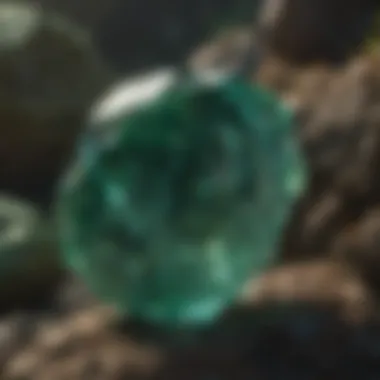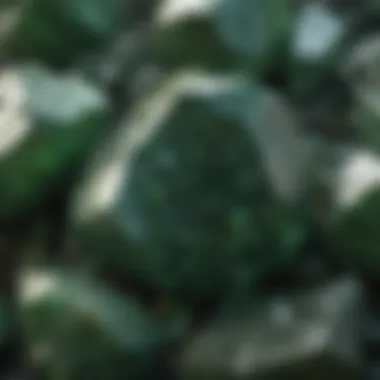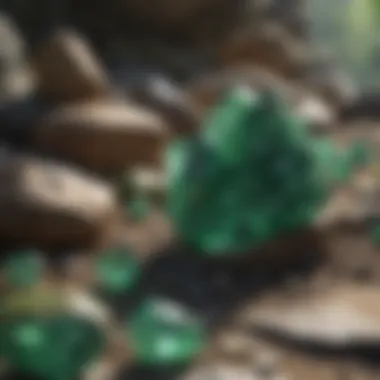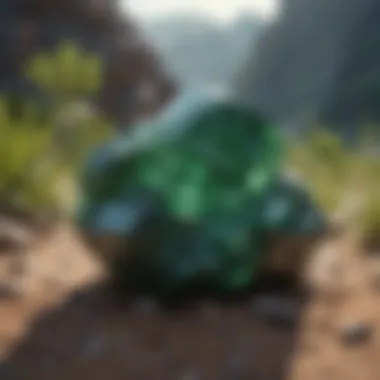Unveiling the Enigmatic Beauty of Identifying Green Crystal Rocks with Precision


Rock and Fossil Identification
In the realm of green crystal rock identification, one must first delve into the finer intricacies of recognizing different types of rocks and fossils. It is essential to familiarize oneself with the various characteristics that set these green crystal specimens apart. Whether examining the crystalline structure, color variations, or mineral composition, attention to detail is paramount. Utilizing specialized tools such as magnifying lenses and hardness testing kits can aid in the identification process, offering a closer look at the unique features of each specimen.
Collecting Tips and Techniques
For avid collectors seeking to expand their green crystal rock collection, adopting best practices in collecting is key. Venturing to prime collecting sites known for their abundance of green crystal specimens is a thrilling endeavor. These locales often harbor hidden treasures waiting to be unearthed. In the art of safely extracting specimens, delicate techniques must be employed to ensure minimal damage during the retrieval process. From gentle prying tools to meticulous excavation methods, collectors must handle each specimen with the utmost care to preserve their integrity.
Preservation and Display
Once a coveted green crystal rock is acquired, the focus shifts towards preservation and display. Employing effective preservation techniques is vital in maintaining the natural beauty of these specimens. From stabilizing fragile structures to safeguarding against environmental factors, proper storage methods play a significant role in long-term preservation. When it comes to creative display ideas, showcasing green crystal rocks in elegant shadow boxes or illuminated glass cases can elevate their aesthetic appeal. Displaying these treasures in a captivating manner not only enhances their visual allure but also showcases the collector's passion for these mesmerizing geological wonders.
Geological Insights
Exploring the geological insights behind green crystal rocks unveils a world of fascinating formations and processes. Understanding the historical significance of these rocks and fossils offers a glimpse into Earth's rich geological past. It is intriguing to delve into notable discoveries in the field, shedding light on groundbreaking findings that have shaped our understanding of these enigmatic green crystal specimens. From the intricate layers of geological formations to the intricate processes that have shaped them over millennia, each discovery contributes to a deeper appreciation for the beauty and complexity of our planet's geological tapestry.
Introduction
Green crystal rocks hold a mysterious allure that captivates the hearts of rock and fossil collectors worldwide. The enigmatic beauty of these specimens beckons enthusiasts to delve deeper into their world, unlocking the secrets they hold within. In this comprehensive guide, we embark on a journey to unravel the intricacies of identifying green crystal rocks with precision and expertise.
Understanding the Significance of Green Crystal Rocks
The Allure of Green Crystals in Geological Collections
Green crystals stand out in geological collections due to their mesmerizing shade of green that symbolizes growth, renewal, and harmony. Their unique coloration sets them apart, evoking a sense of serenity and connection to the natural world. Collectors are drawn to green crystals for their aesthetic appeal and metaphysical properties, making them a popular choice for those exploring the depths of earth's treasures. Expanding one's collection to include these alluring specimens adds depth and vibrancy, enriching the overall presentation and diversity of geological displays.
The Geological Formation Process of Green Crystals
The formation of green crystals is a complex geological process shaped by various factors such as pressure, temperature, and mineral composition. These crystals can form in diverse environments, including metamorphic regions rich in minerals like copper, chlorite, or malachite. Understanding the geological processes that give rise to green crystals provides collectors with valuable insights into the earth's history and the forces that have shaped its landscape over millennia. By exploring the origins of green crystals, enthusiasts gain a deeper appreciation for these gems and the intricate natural processes that create them.
Overview of Green Crystal Rock Identification
Importance of Accurate Identification in Collection Valuation


The precise identification of green crystal rocks is paramount for collectors seeking to assess the value and authenticity of their collections. Accurate identification ensures transparency in trade and enhances the credibility of geological specimens. Collectors who master the art of identifying green crystals can make informed decisions regarding acquisitions and valuations, elevating the quality and sophistication of their collections. Therefore, emphasizing the significance of accurate identification in collection valuation empowers collectors to navigate the market with confidence and precision.
Common Types of Green Crystal Rocks
Green crystal rocks encompass a diverse range of varieties, each with its distinct characteristics and properties. From emerald to malachite, the spectrum of green crystal types offers collectors a myriad of options to explore and appreciate. Familiarizing oneself with the common types of green crystal rocks not only expands one's knowledge base but also deepens their appreciation for the richness and diversity of earth's mineral treasures. By distinguishing between different green crystal varieties, collectors can refine their expertise and develop a discerning eye for quality specimens.
Physical Characteristics
Green crystal rocks possess an inherent allure in the field of geological collections. The color variations, crystal structures, and chemical compositions provide valuable insights into the history and formation processes of these exquisite specimens. Understanding the physical characteristics of green crystal rocks is paramount for collectors, as it aids in accurate identification, valuation, and appreciation of their geological significance. By examining the color variations, crystal structures, and textures, enthusiasts can unravel the enigmatic beauty of these minerals with precision and expertise.
Color Variations in Green Crystal Rocks
Shades and Intensity of Green Hues
The shades and intensity of green hues in crystal rocks play a pivotal role in their overall appearance and desirability. The variations in green tones, ranging from vibrant emerald greens to subtle mossy hues, add complexity and depth to these specimens. Collectors often gravitate towards stones with vivid and rich color saturation, as they are considered more valuable and aesthetically pleasing. The uniqueness of each shade showcases the diversity found in nature's creations, offering collectors a wide spectrum of choices to explore and admire. Understanding the nuances of green hues can guide enthusiasts in differentiating between various types of crystal rocks and appreciating their individual characteristics.
Inclusions and Patterns
Inclusions and patterns within green crystal rocks provide further layers of intrigue and fascination for collectors. These internal features, such as mineral deposits, fractures, and growth patterns, offer insights into the geological processes that shaped these minerals over time. By examining these inclusions and patterns under magnification, enthusiasts can uncover clues about the environmental conditions in which the crystals formed. The presence of unique formations, such as dendritic patterns or mineral inclusions, adds to the beauty and storytelling potential of each specimen. However, excessive inclusions or irregular patterns may affect the clarity and value of green crystal rocks, making it essential for collectors to assess these aspects carefully.
Crystal Structure and Texture
Forms of Green Crystals (e.g., Prismatic, Cubic)
The forms of green crystals, whether prismatic, cubic, or irregular, contribute to their overall visual appeal and structural integrity. Each crystalline shape reflects the internal atomic arrangement of the mineral, showcasing distinct geometric patterns and symmetries. Collectors often appreciate crystals with well-defined and symmetrical forms, as they exhibit crystalline perfection and aesthetic beauty. The diversity in crystal structures allows enthusiasts to explore the intricacies of mineral formation and growth, highlighting the fascinating processes that occur deep within the Earth's crust.
Surface Smoothness and Transparency
The surface smoothness and transparency of green crystal rocks influence their optical properties and luster, enhancing their visual impact and allure. Smooth surfaces with high transparency levels allow light to pass through the crystal easily, creating stunning visual effects and reflections. Collectors are drawn to crystals with pristine surfaces and excellent transparency, as these qualities indicate purity and quality. However, variations in surface textures, such as etchings or natural fractures, can also provide clues about the crystal's history and formation. Understanding the relationship between surface smoothness, transparency, and overall quality is essential for collectors to assess the value and beauty of green crystal rocks.
Chemical Composition
Green crystal rocks enthrall enthusiasts with their enigmatic allure, revealing a mesmerizing world waiting to be unveiled. In this insightful journey, understanding the chemical composition of these unique specimens plays a pivotal role. The composition forms the essence of these rocks, influencing their characteristics and allure. By delving into the specific elements constituting green crystals, such as copper, chlorite, or malachite, enthusiasts can unravel the secrets embedded within these captivating formations, gaining a profound insight into their formation and significance. The chemical composition acts as a blueprint, guiding collectors in distinguishing between various types of green crystal rocks, enhancing their collection evaluation prowess.


Identification through Chemical Tests
Reactivity to Acids and Other Substances
The reactivity of green crystal rocks to acids and other substances serves as a cornerstone in the identification process, offering a unique window into their composition. This distinctive characteristic allows collectors to discern the authenticity and purity of a specimen, contributing significantly to the overall goal of accurate identification. The reactivity to acids and other substances manifests as a valuable tool for enthusiasts, aiding in differentiating between genuine green crystal rocks and imitations. Embracing this aspect enriches the identification journey, providing clarity and certainty in distinguishing sought-after specimens.
Distinguishing Features in Spectroscopic Analysis
Delving into the intricate world of spectroscopic analysis unveils a realm of distinguishing features essential for accurate identification. By exploring the unique spectral patterns exhibited by green crystal rocks, enthusiasts can unlock a treasure trove of information, shedding light on their composition and origin. Spectroscopic analysis stands as a reliable method for enthusiasts to delve into the intricate details of green crystal specimens, offering a scientific approach to unraveling their mysteries. Embracing this technique enhances the identification process, enabling collectors to decode the hidden nuances within each specimen.
Common Minerals Associated with Green Crystals
Presence of Copper, Chlorite, or Malachite
The presence of copper, chlorite, or malachite within green crystal specimens encapsulates a fascinating aspect of their composition. These minerals embed unique characteristics within the rocks, contributing to their distinctive allure and charm. By recognizing the significance of these minerals, enthusiasts gain valuable insights into the composition of green crystals, fostering a deeper appreciation for their geological origins and formation processes. Exploring the presence of copper, chlorite, or malachite enriches the identification journey, offering collectors a nuanced understanding of these captivating specimens.
Impact of Geological Environment on Composition
The geological environment exerts a profound influence on the composition of green crystal rocks, shaping their formation and characteristics. Understanding the impact of geological settings, whether associated with metamorphic or igneous rocks, provides enthusiasts with crucial knowledge to unravel the mysteries of these specimens. The geological environment acts as a silent architect, sculpting the intricate features and patterns found within green crystals, showcasing the dynamic interplay between nature's forces and mineral formation processes. Delving into the impact of geological environments enhances collectors' comprehension, offering a deeper connection to the rich tapestry of green crystal formations.
Geological Sources
Geological sources play a pivotal role in understanding the origins of green crystal rocks. By exploring the geographical locations where these captivating specimens are found, collectors gain valuable insights into the unique formation processes and environmental conditions that contribute to their distinctive properties. Studying famous green crystal deposits around the world provides a deeper appreciation of the diversity and geological significance of these rocks, enhancing the overall rock identification experience.
Famous Green Crystal Deposits
Emerald Mines of Colombia
The Emerald Mines of Colombia stand out as prominent sources of exquisite green crystals, renowned for their exceptional quality and vivid hues. These mines have long been celebrated for yielding some of the world's most sought-after emeralds, adding a layer of prestige to the green crystal realm. The key characteristic of the Emerald Mines of Colombia lies in their rich deposits of emeralds, showcasing a remarkable intensity of color and clarity. This unique feature makes them a highly desirable choice for collectors and gem enthusiasts alike, elevating their status in the world of green crystal rock identification.
Green Quartz in Brazil
Green Quartz from Brazil emerges as another noteworthy player in the realm of green crystal rock deposits, offering a distinct mineral composition and visual appeal. The key characteristic of Green Quartz in Brazil is its vibrant green coloration, attributed to trace elements present in the quartz crystals. This specific feature makes it a popular choice for collectors seeking unique and aesthetically pleasing specimens for their collections. The advantage of Green Quartz from Brazil lies in its availability in various shades of green, catering to a wide range of preferences within the world of green crystal identification.


Formation Conditions and Geological Settings
Impact of Pressure and Temperature
The Impact of Pressure and Temperature on the formation of green crystal rocks holds paramount importance in understanding their geological origins. The key characteristic of this aspect lies in how varying pressure and temperature conditions influence the crystallization process, leading to the formation of distinct green crystal structures. This unique feature allows collectors and geologists to interpret the environmental history encapsulated within each green crystal specimen, offering insights into the dynamic forces at play during their formation.
Association with Metamorphic or Igneous Rocks
The association of green crystal rocks with metamorphic or igneous rocks provides valuable context to their geological settings and mineralogical composition. The key characteristic of this association is the indication of past geologic events that have shaped the green crystal deposits over time. Understanding this unique feature allows collectors to appreciate the evolutionary narrative embedded within these rocks, shedding light on the intricate processes that have contributed to their current state. Exploring the relationship between green crystals and metamorphic or igneous rocks enriches the overall experience of rock identification, offering a holistic approach to studying these fascinating geological wonders.
Identification Techniques
Identification Techniques play a pivotal role in unlocking the mysteries surrounding green crystal rock specimens. In this specialized field, precision and accuracy are paramount, ensuring collectors and enthusiasts can confidently classify and appreciate the beauty of these geological treasures. By delving into the nuances of Identification Techniques, individuals can enhance their understanding of green crystal rocks, distinguishing between various types and appreciating the unique features that shape their allure.
Methods for Accurate Determination
Crystallographic Analysis
Crystallographic Analysis represents a cornerstone in the realm of green crystal rock identification. By scrutinizing the geometric arrangement of atoms within crystal structures, collectors can glean invaluable insights into the composition and properties of these specimens. The meticulous examination facilitated by Crystallographic Analysis allows for precise categorization, enabling enthusiasts to differentiate between similar-looking crystals with confidence. Although requiring specialized knowledge and equipment, Crystallographic Analysis stands as a reliable method in accurately determining the identity of green crystal rocks.
X-Ray Diffraction for Mineral Identification
X-Ray Diffraction for Mineral Identification emerges as a prominent tool in the pursuit of distinguishing green crystal rocks. Through the interaction of X-rays with the crystal lattice, this technique provides a unique fingerprint of the mineral composition present in specimens. The distinct patterns produced offer detailed information on the crystal structure, aiding collectors in determining the specific minerals comprising the green crystals. Despite its sophistication, X-Ray Diffraction remains a widely accepted method due to its precision and ability to unravel the chemical composition of green crystal rocks.
Utilizing UV Light and Magnification
Bridging science and aesthetics, the utilization of UV Light and magnification unveils hidden dimensions within green crystal rocks. Illuminating the fluorescent properties of these specimens, Fluorescence Patterns in Green Crystals offer a dazzling display, showcasing intricate details invisible to the naked eye. This technique not only enhances the visual appeal of green crystals but also aids in identification, as different minerals exhibit distinct fluorescence under UV light. Conversely, Microscopic Examination of Crystal Features elevates the scrutiny to a microscopic level, unveiling minute characteristics that define each green crystal specimen. While demanding patience and skilled observation, microscopic examination provides unparalleled insights into the intricate world of green crystal formations, enriching the identification process for passionate collectors.
Conclusion
The Conclusion section of this article serves as the pinnacle of our journey through the intricate realm of Green Crystal Rock Identification. It encapsulates the essence of our exploration and underscores the significance of delving into the mysteries of green crystal rocks. By synthesizing the wealth of information and insights shared throughout this comprehensive guide, readers are equipped to appreciate the nuances and complexities involved in identifying and understanding these enigmatic specimens. In essence, the Conclusion acts as a roadmap, guiding enthusiasts towards a deeper understanding of green crystals and fostering a sense of curiosity and appreciation for the geological wonders that abound.
Mastering the Art of Green Crystal Rock Identification
Key Takeaways for Aspiring Collectors
Exploring Key Takeaways for Aspiring Collectors unveils a wealth of essential insights crucial for honing one's expertise in identifying green crystal rocks. These takeaways serve as guiding beacons, illuminating key facets such as color variations, crystal structures, and chemical compositions that are paramount in accurate identification. The significance of these key takeaways lies in their ability to arm collectors with the knowledge needed to differentiate between various types of green crystal rocks with precision and confidence. By understanding the subtle differences and distinguishing features, aspiring collectors can elevate their collecting experience and develop a discerning eye for these captivating specimens.
Continuous Learning and Exploration in Geological Sciences
Embracing Continuous Learning and Exploration in Geological Sciences is fundamental in fostering a deep appreciation for the complexities of green crystal rock identification. This approach encourages enthusiasts to venture beyond the surface level and delve into the depths of geological knowledge, perpetually expanding their understanding and perspective. The key characteristic of continuous learning lies in its adaptive nature, allowing collectors to stay abreast of new discoveries and advancements in the field. This perpetual quest for knowledge not only enriches the collecting experience but also instills a sense of awe and wonder at the natural processes that shape these mesmerizing green crystals. While the journey of continuous learning may present challenges and complexities, the rewards of acquiring in-depth geological insights far outweigh any obstacles, paving the way for a lifetime of exploration and discovery.







